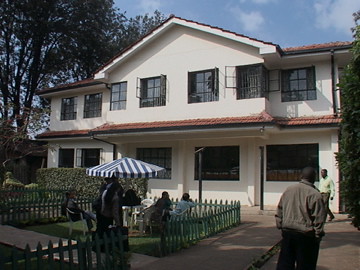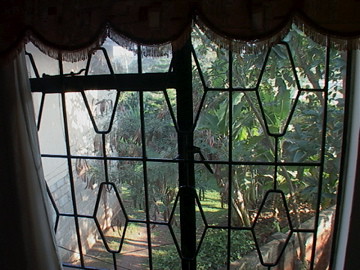
Ring, Ring.
My first thought was that a telephone was ringing somewhere in the guesthouse. I could hear the TV downstairs, in the dining room, from inside my room directly above. The walls were thin in this country. So when I heard the ringing, while fooling around with the video camera in my room, I naturally thought a telephone was calling out to be answered.
Then I heard voices laughing and carrying on as if they were standing under my window. I looked up at the window and saw that it was open. The temperature this time of year in Kenya stays in the low 70’s so I figured the windows were open all of the time. I went over to the open window to look for the source of the laughter.

The crowds of uniformed Kenyan teenagers were not right under my window but they were only a few yards away on the other side of a hedgerow. When I saw the students from the English school next door filing out into the narrow yard that separated the guesthouse from the school, a light bulb popped on in my head. The ringing that started all of this was the school bell. Then Grace came into my room and asked, “Do you see the British school children out your window?”
Soon after breakfast we were off to Grace House. I had been looking forward to finally seeing the building I had spent so much time producing fundraising videos for. Earlier in the year I spent several evenings staying late at work to edit together photographs of the construction of Grace House. Now it was time to reach out and touch the bricks and mortar with my own fingers.
The drive out to Grace House took us out of Nairobi and into the suburb of Kiambu. I stuck the camera out of the window and tried shooting while we drove. At first Nairobi seemed to be like most other cities I have visited during my travels. We drove past several tall skyscrapers made of steel and glass. Traffic was heavy with small Japanese cars and European cab over diesel trucks. I did see a lot of people walking along worn out dirt paths beside the road. I asked Fr. Lawrence where were the sidewalks and he just looked at me and grinned. It was hard to believe that the third largest city in the entire continent of Africa didn’t have enough of a tax base to raise money for simple sidewalks.
Soon the city streets gave way to tree lined roads. There were still a lot of people walking along the side of the road even out in the more rural areas. Most Kenyans don’t own cars so they have to walk to where they need to go. Kinda makes a fellow who has three cars in his driveway feel a little guilty.

I started to enjoy the ride more out here away from the congested city streets. The endless rows of drab concrete buildings were not as pleasant to look at as the coffee farms and villages. Out here, I saw a lot of plants and trees I’ve never seen before. The landscape rose and fell in a series of ridges and valleys similar to the foothills where we live back in the U.S. Similar but very different. There were lots of trees but no heavily forested areas. Nearly every patch of land was used to grow a crop. The dominant tree was the banana tree. It only grew to about half the height of the trees back home and didn’t have a thick trunk covered in bark. Instead of branches, large leaves several feet long grew out of the slick green trunk. Huge purple pods hung down under the leaves with slim green bananas growing out above the pods. The coffee trees looked like rows of shrubs growing in fields. They resembled bushes instead of trees. They were short and had small leaves. They were short because the farmers kept them trimmed back like apple trees here. If you don’t trim them every year they don’t produce as many beans.
Before going to Grace House we stopped at Fr Lawrence’s Kenyan home. To get to his house we had to travel a few miles up a treacherous single lane dirt road. When I say dirt road, I’m not talking about the graded gravel roads found in rural areas back home. These roads were packed clay with no gravel at all. They were deeply rutted and extremely narrow. You could reach out your hand and touch the branches of the bushes on either side of the road. I had a hard time imagining the fact that people drove small Japanese cars up and down these dirt trails they call roads. Back home I would only attempt one of these if I were driving with four-wheel drive. Today we were rocketing up the path in a Toyota sedan. Impressive to say the least.

I was also impressed with Fr. Lawrence’s home. Not that it was large and ornate. It was just the opposite. I was impressed with its construction. It was built out of handmade bricks that are about the size of the large grey blocks we use in the States, except the bricks were solid instead of hollow in the center. This was one solid ranch style house tucked in between banana trees and cow pens. I asked about the bricks and Fr. Lawrence told me they were six inches by nine inches. Monsters. A large painted metal door hung in the doorway. Single pained glass windows hung behind painted steel bars all around the house. The steel bars are to prevent intruders. No Alarm Force security systems here. Terracotta shingles covered the roof. This place was built to last. As I took in all of the details I thought this house would still be standing long after my house in America has crumbled to the ground.
We were only at Fr. Lawrence’s house, or I should say his family’s house, for a brief moment. Here in Kenya, the entire family lives together in a family compound. They may all live in the same house or they may have a bunch of small houses spread around the property. But, they all pitch in and work the family farm together. I wonder what it would be like if the Corn family all still lived together on my Grandfather’s land like I did as a child. Maybe I would’nt be sinking in a mountain of mortgage payments like I am now. Unfortunately, I didn’t get to look inside. We dropped our luggage and headed off for Grace House. Maybe I would get to see inside later.
Today is family day for the young men that made up the very first class of residents at Grace House rehabilitation center. When we arrived, some families were already gathering together under a shade tree in the courtyard. I was eager to explore the three-story building but Fr. Lawrence kept me busy by introducing me to everyone. I was the only American in the crowd and everyone was eager to meet me. I’m not used to having the guest of honor status at a gathering for folks.
I did manage to take a quick peek inside after I shook everybody’s hand. Only the bottom floor of the building is in use at this time for the center. Fr. Lawrence has four beds to a room in four different rooms. He has two more floors of rooms he needs to furnish before the center will be fully operational. The kitchen has only one small table and most of the cooking utensils are laid out on a cloth on the floor. There’s no oven or microwave, only gas camp stoves and cooking pots filled with coal. Basically, the only furniture I saw was plastic outdoor chairs, the bunk beds in the dorms and the one wooden table in the kitchen. The place reminded me of the Boy Scout camp I used to spend summers at when I was young.
Lunch was served soon after we arrived. I was talking with a father of one of the residents when a lady walked up to me and handed me a plate piled high with food. No one else had a plate yet so I was feeling a little uncomfortable being the only one to have food. I’m not used to being the guest of honor. The ladies were bringing out plates quickly so I wasn’t the only one for long.
I love Kenyan food. Grace introduced me to the Kenyan style of cooking back in the States. My favorite dish is made of mashed potatoes mixed with spinach and kernels of corn. They call this dish mukimo. Grace’s mukimo was the first, and up until this day, the best I have ever tasted. I hope I don’t offend Grace by saying that the mukimo here at Grace house was outstanding. The young woman I saw working in the kitchen earlier had added a few extra ingredients like onion, lima beans, and milk. Wow. After the meal I went and found the young lady to thank her for making the best mukimo I’ve ever shoved in my mouth.
The crowd grew larger and larger as we ate. More family members kept coming through the gate. Here in Kenya there is regular time and what we Americans call Kenyan time. Here nothing starts on regular time. As I have said before, not everyone owns a car. Some people have to walk while others have to catch a ride with a friend or a bus. It’s hard to predict how much time travel will take. I’m sure there are other factors contributing to Kenyan time but travel seems to be the one I see most often.
Suddenly, Fr. Lawrence jumped and began speaking to the crowd. I couldn’t understand a word he was saying because he was speaking in Kikuyu. I have learned that Swahili isn’t the only language spoken in Kenya. It’s a universal language across the continent of Africa but many different languages are spoken in different areas. Where I was, there are people who speak Kikuyu and others like the Massi who have their own language. So even if I had taken the trouble to learn Swahili, I still wouldn’t have been able to follow along with Fr. Lawrence’s speech. It also means that they speak a minimum of three different languages. They speak their native language, Swahili, and English. What does that tell you about us Americans?
After Fr. Lawrence gave his speech, he asked for each one of the fifteen men in the program to stand up and introduce himself and his family. I was surprised to see that everyone had a little speech to give as well. They didn’t just stand up and say their name and sit back down. They had something to say. When the men introduced their families, one or two of the family members would stand up and give a few words as well. This was not what you would call a bashful bunch.
The men were talking about their struggles with addiction. Back home, people are so private and afraid to admit they have a problem, there’s no way they would stand up in front of a group of strangers and talk about their addiction. I myself wouldn’t be able to stand here and tell them some of the stupid stuff I have done over the years. I was amazed at the openness of the speeches.
I had the fine fellow sitting beside me lean over and give me the highlights of each speech in English. Just hearing the highlights genuinely moved me. I began thinking about how rich this environment was for emotional stories to tell in my video. But, I also wondered how hard it was going to be getting some of these men to open up to my camera. The kind of testimonies these men were giving the families gathered today were perfect for pulling at the heart strings of my audience if I could get all of this moving sound on tape.
As I heard the translation of the testimonies, I thought about these stories as much more than good sound for my project. I believe these guys would serve as good examples for people in America suffering from alcohol addiction. I was inspired by their openness and willingness to confess their wrong choices to all of us gathered here. I think Americans in this situation would blame their problem on something other than themselves. I don’t think they would take responsibility for their behavior like these guys have. We are so quick to blame our problems on things like a difficult childhood or abusive relationships. From what I was hearing today, these guys would never think to place the blame on anything other than themselves. They didn’t play the part of being a victim. They atmitted to making some wrong decisions.
The personal testimonies went on for several minutes. Everyone was sitting in a circle and soon the fellow sitting next to me stood up and addressed the crowd. While he talked, Fr. Lawrence leaned over and whispered “your next.” Oh boy, I should have expected this. I have been to several Kikuyu gatherings back in Charlotte. Everybody, and I do mean everybody, stands up and says something about why we are all gathered together. So I managed to suppress a panic attack and got up in front of the crowd. I told the men about how I was moved by their openness to share their testimony with everyone here including me. I also told them how I believed their stories could possibly inspire Americans struggling with the same problems to reach out to a larger group just as these men have. I said I thought Americans could learn a thing or two from the Kenyans and how I wanted to capture all of their stories with my lens.
I think the men understood exactly what I was there for. After the program, several of the men came up to me and started repeating their testimony right away. I had to explain to them I wasn’t working at that moment and I reassured them I would be around the entire week to see each one of them individually. My worries about these guys not wanting to go on camera were totally wrong. They couldn’t wait to get started. I felt like a kid in a candy store. I’m used to having to beg people to tell me their stories. My own grandfather wouldn’t let me tape him talking about his experiences during WWII. Now I have fifteen men waiting in line to go in front of my camera. Amazing.
Before the program ended, Grace, the lady who was the inspiration for the name of the rehabilitation center, stood and gave the final speech. I had to get out the camera and get shots of this. I thought a sequence of Grace talking in front of a crowd gathered at Grace House would be perfect for my project. Even though she was talking in Kikuyu, I taped the entire message thinking she could translate for me later. Every once in a while she would switch back to English for a sentence or two. I hear her say something about getting yourself out of a “pit.” The word reminded me of the book Grace was reading on the plane. She studied and took notes out of this book the entire time we were in the air. The name of the book was Get Out of that Pit. On the plane, Grace was preparing for the message she was delivering right now. She had prepared for this mission trip by studying her book just like I studied the manual to the new camera. In that moment, I realized this was not going to be a vacation. We were here to do some serious work in the mission field. Everybody was prepared for the jobs they had to do.
A thunderstorm ended the program and my taping for the day. It was just as well, we needed to head back to the airport to pick up the rest of the team. This time I stood outside of the wall of windows, looking in on the people milling around baggage clam. The feeling of being at a zoo was even stronger from this side. I was tired and wanted to lay my head on a pillow. I knew I was going to be working hard the next several days, and I didn’t have much patience for standing around at an airport. Fr. Dan and Debbie finally came out of baggage claim and we all rode in the back of a pickup truck to the place where we were staying for the night. I was more than ready for that thin foam mattress.


1 comment:
Polisher, thanks for the props. I know my posts have been slow in coming but I'm trying to edit two docs. on the trip while posting the journal. Plus my copy editor (aka wife) got a job and has me waiting in line behind the kids homework for correction.
I almost gave up getting it all posted but you have reminded me that I'm not just posting this for myself. Thank you for reading and keeping me on my toes.
No problems dood. I check in every couple of days to see how things are going. I don't mind the wait. The story is good, and the reason for the story is great.
Best to you, the Missus, and the little kernels.
Post a Comment